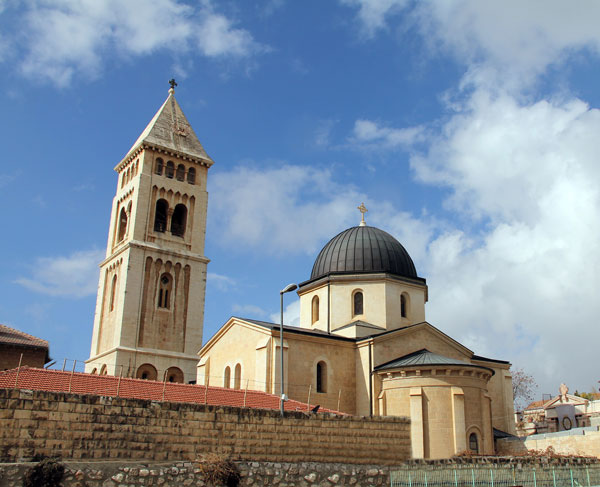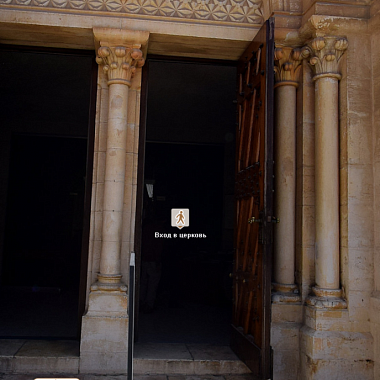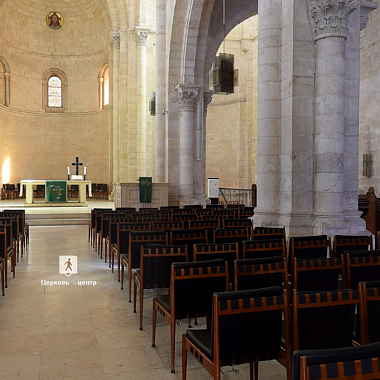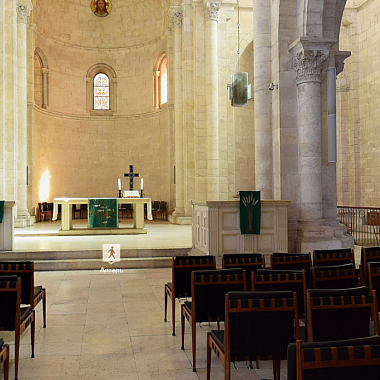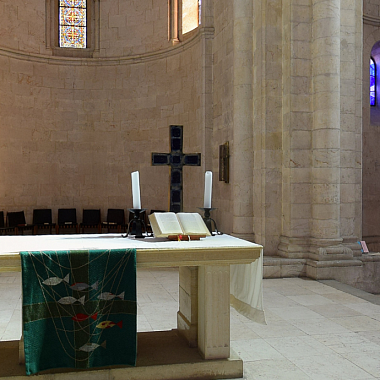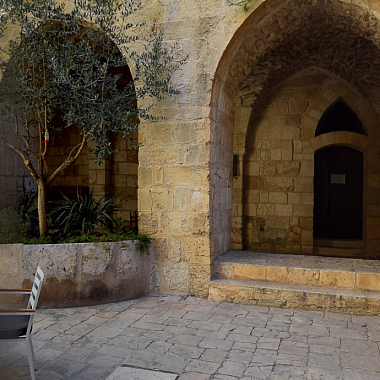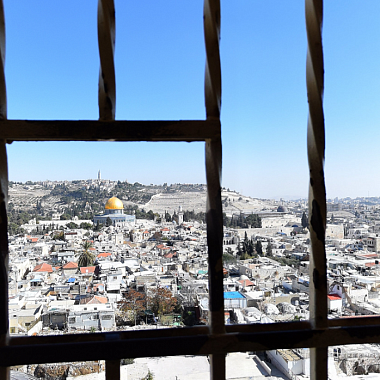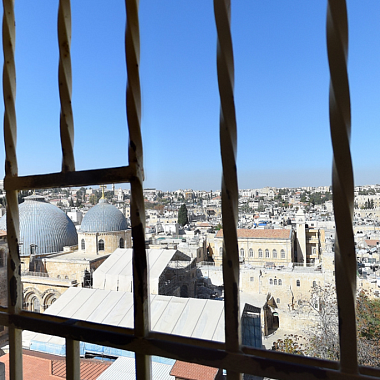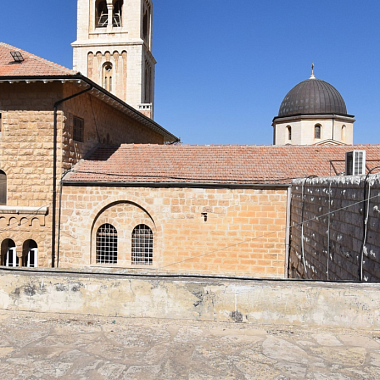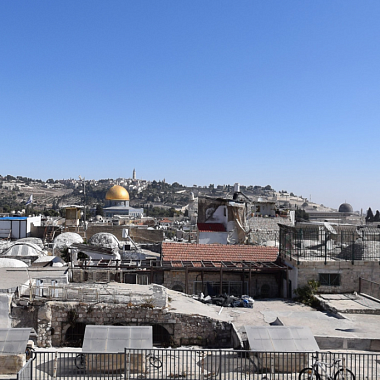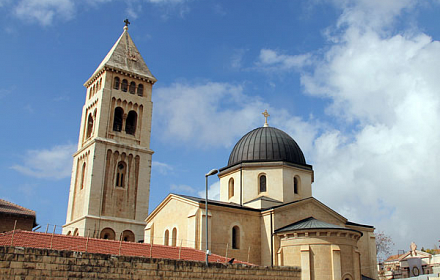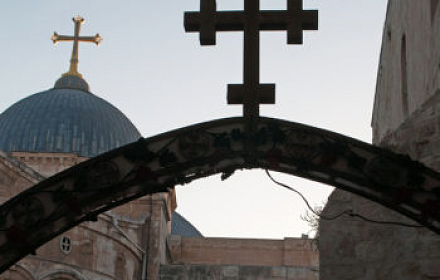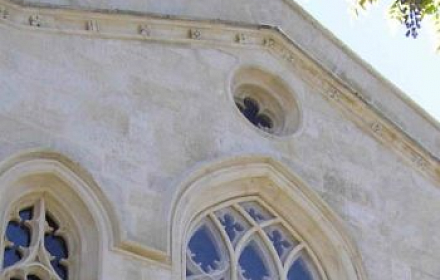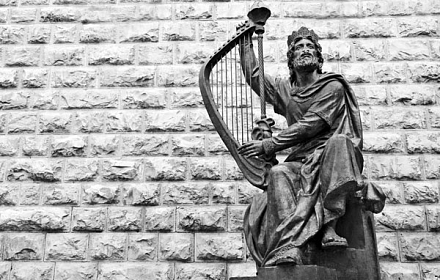About Virtual Tour
Entrance
In the Old City there are holy sites of different Christian confessions. Some among them are affiliated with Lutheran Christians. The major Protestant church in Jerusalem bears the name of Christ the Redeemer. It’s an unavoidable landmark in the Christian Quarter — the building has a high bell-tower and combines western and eastern architectural styles. By local standards, this church in the Muristan compound is relatively young — it was built in the last decade of the 19th century. However its history stretches back to the times of the Kingdom of Jerusalem, when there stood a convent named St. Mary Latine Minor (Santa Maria La Latina) built by the Knights of the Cross. In its turn it rests on the foundations of an earlier Byzantine basilica of the 5th century A.D. This fact was very important for Lutherans who strived to take root in the Holy Land throughout the whole nineteenth century, but encountered resistance from the old Christian denominations of East and West. Lutherans needed a historical landmark to become a cornerstone of their future church, and the remains of the Crusaders’ basilica became the right place. Ottoman authorities were interested in Germany as a powerful ally, and therefore granted German Christians this plot of land in the Old City, all the more since German emperor Wilhelm II was interested in this possession. Later, the remnants of the medieval work were integrated into the new Protestant church. The traces of the signs of the zodiac can still be seen from the unused northern entry, which faces Via Dolorosa. Behind the remains of solid walls built by Crusaders now stands St. John’s Chapel. Let's go on a virtual pilgrimageChurch
The construction of the Lutheran Church of the Redeemer in the Christian Quarter was completed in the closing years of the 19th century. It was consecrated on October 31, 1898 – the Reformation Day – in the presence of German emperor Wilhelm II within the framework of his historical visit to Jerusalem. The German Imperial Household provided active financial support in the construction – the reason for the Kaiser to attend the inauguration ceremony in person, in company of his spouse and close relatives. According to historical statements, the German emperor was very satisfied with the visit.The Holy Land’s history in the 20th century was abundant in various events that made a big renovation and some reconstruction works necessary. Church of Christ the Redeemer was successfully renovated in 1970s. Besides restoration work, some new elements were introduced — in particular, picturesque mosaics were added both inside and outside.
Today the building is a property of the German Evangelical Jerusalem Foundation (Deutsche Evangelische Jerusalemstiftung) with headquarters in the city of Hannover. The same organization owns another Jerusalem landmark — the Chapel of the Ascension on the Mount of Olives. We will not talk about this shrine today, but instead we’ll have a look inside the Church of the Redeemer.
Church-center
Pale walls, high arch spans and the light coming from the windows and open doors make the church building look more spacious from the inside than from the outside. The interior of the Church of the Redeemer as we see it today was formed during the renovation works in 1970s. The church windows feature fascinating colored stained glass artworks created by the glass artist Anna Anders-Markus.Before the construction of this church started in 1883, the Lutheran community in Jerusalem went a century-long way of growth. The German community began its formation in the beginning of the 19th century. The Anglican-German Bishopric in Jerusalem was officially established only in 1841 — when the two European countries with Protestant majorities became allies. This organization tried to unite Protestant Christians who lived in Palestine and also to convert local Arabs to their faith. Today, the divine services are held in German, Arabic and English.
Finally, in 1871 a German-speaking Lutheran congregation was established in the former crusader church.
Altar
Two rows of columns support three naves with semicircular apses. While on the outside the church building combines European and Middle Eastern architectural styles, its interior is designed in the simple style of Romanesque Revival architecture. It has no mural paintings, which corresponds to Lutheran church esthetics philosophy. There is also a legend, which is popular among German Protestants, which suggests that the sketch of the Church of the Redeemer was drawn personally by German emperor. Whether that was the case or not – we cannot know for certain, but we know for a fact that he drew the sketch for the bell-tower, which is the highest in the Old City. We will return here a little bit later.The main point of interest in the Church of the Redeemer, which attracts not only Lutherans, but also music lovers of different religions, is its remarkable pipe organ. To them its special sound means every bit as much as the remnants of the 11th century crusader church. The organ was made in 1971 in the city of Berlin by the famous master Karl Schuke. The instrument has 21 drawbars, connected with two keyboards and the foot-key. The sound of the German organ has been so impressive, that the Church of the Redeemer became one of the most popular Jerusalem destinations among classic music lovers — and certainly the most popular venue for organ concerts.
Inner yard
The church has very good acoustics. The altar in its center is not big and modest. Its internal decoration consists only of a big cross on the wall, candles in big candleholders, some fresh flowers on the altar and antimension adorned with fishes — one of the best known early Christian symbols, now widely used by Protestants. Every spoken word can be heard anywhere in the church. However during the divine service, a microphone is placed in front of the altar – so to say, just in case.Lutheran liturgy is slow, accompanied by the sounds of the organ and finishes with an informative sermon — could be quite time consuming. This is why there are many chairs inside the church for congregations and visitors. There are also some for prayer meetings held in St. John’s Chapel, which stands on remnants of the medieval church.
The Church of the Redeemer has one remarkable feature, which is unique to Protestant churches. Although it’s a Lutheran congregation, inside there are offices representing other confessions — Evangelists, Calvinists, United Church of Christ. Something of this sort is simply unthinkable for Orthodox or Catholics.
Bell-tower
The inner yard from the southern side of the church fits harmoniously into the residential neighborhood. Surrounded with galleries, it was accessorized during the renovations in 1970s. Here, in the shade of broad-crowned trees there is a rest area with benches for worshippers and tourists interested in Jerusalem antiquities. So there is also much to see outside the church. For example, there is a monument to the memory of Knights of Saint John. But most tourists are attracted by the church museum, which looks rather like an archaeological park. At the time of the church construction and since then, there has been one of archaeological excavation sites. Ancient finds discovered by several generations of archaeologists were sufficient to create an impressive exhibition. The exhibits illustrate not only the church history, but also that of the whole city of Jerusalem. Rare coins alone – showing various stages of city planning and development – there are dozens of them. There are some other noteworthy artifacts, especially considering that the most ancient traces of human activities in Muristan date back to 7th century B.C. In those times there were quarries in this area, from which stones were extracted for the ever-growing Jerusalem.Bell-tower2
The western entry into the Church of Christ the Redeemer is adorned with a symbolic depiction of the lamb with two shields: one bearing the Knights Hospitaller cross and another – the imperial eagle. Thanks to such “signboard”, no questions arise even from an ignorant person regarding its national affiliation. In the same way as England, Russia or France, Germany has its own history of presence in the Holy Land — in Modern time it was marked by creation and missionary work, rather than wars.As mentioned above, in 1869 Turkish sultan Abdulaziz assigned the plot of land with remains of the 11th century crusader church in favor of the Prussian King. The crown prince Frederick William of Prussia, returning from the inauguration of the Suez Canal in November 1869, stopped here for a flag-raising ceremony. Some twenty years after these events, German emperor Wilhelm II undertook to build a Lutheran church. Of course, not everything was funded at the expense of the sovereign or the state treasury. Germany, which at that time became a united state, had enough of hostiles all over Europe — consequently, this required greater expenses. That is why the Evangelical Jerusalem Foundation was established to raise funds for construction of the first Lutheran church in the Holy Land. In commending the work of the organization, it should be noted that the necessary sum was collected in just a few years. Although without Kaiser’s help in the amount of about one million German marks, its official inauguration day would have been postponed for at least ten years.
Lutheran Church view
The principal plan of the Church of the Redeemer was designed by the famous German architect Friedrich Adler and finalized by Paul Ferdinand Groth, who supervised the construction. We remember that emperor Wilhelm II was also among those who lent a hand – he assisted in designing the bell-tower. We cannot know for certain the reasons why the German Kaiser wanted it to be so high. It could be that for Lutheran and Protestant churches in general there was no place inside the Church of the Holy Sepulcher, so that the highest bell-tower in the neighborhood was some sort of compensation. Today, for a 15-sheckel ticket you can climb 178 stairs to the bell-tower’s sightseeing platform. However, some count only 177 of them. Anyway, neither figure has any symbolic importance — it’s simply the number of steps needed to complete the staircase, which leads to the bell-tower’s top.It offers breathtaking views of so many Jerusalem’s holy sites that you won’t be able to explore on foot even within three days. Among them are: the Church of the Holy Sepulcher, The Hurva Synagogue and the principal Muslim holy site in Jerusalem — the Dome of the Rock on the Temple Mount. From here one can perfectly see a pavilion on the roof of the “Russian House” – Alexander Nevsky Compound, as well as another high bell-tower, which belongs to the Franciscan monastery of Saint Savior. Other easily recognizable landmarks that dominate the city skyline are: the bell-tower of the Russian Orthodox Church of the Ascension, Augusta Victoria Hospital and the Hebrew University of Jerusalem.
Old City view
The Church of the Redeemer’s bell-tower has multiple levels and a height of 40 meters. Although this place of worship is located in the Christian Quarter of the Old City, from the viewing platform you can perfectly see three other quarters: Armenian, Jewish and Muslim quarters. For this reason, many walking tours across the Holy City begin or end here. Besides the pilgrims and tourists who climb up to the bell-tower’s top, among the frequent visitors are birds and bats that find shelter among the clefts in the rocks.The church and its bell-tower have distinctive German national features and can be described as eclectic, as during its construction it was decided to preserve the remnants of the old crusader church. The main entry and some other parts of the building are in the same style. Interestingly, the place world known as The Church of the Redeemer is officially named “The Evangelical Lutheran Church of the Redeemer”. Its history offers a shining example of peaceful coexistence of different religions in the Holy Land. Take, for example, its consecration day — two arches were built for the imperial inauguration ceremony: one for the Ottoman Empire’s Muslims and the other for Jerusalem Jews. Today the people of different confessions continue to get together in this place. This usually happens once a month, on one of Saturday nights, when the Church of the Redeemer briefly becomes a temple of art for lovers of classical music.
Send donation
If you are in a difficult financial situation, we will light the candle for free. For that purpose email us at coordinator@santosepulcro.co.il
Payment Methods
